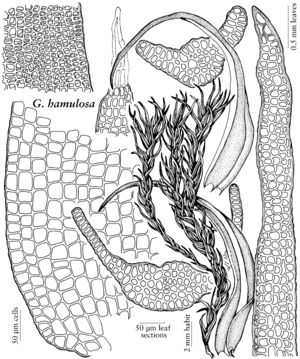Grimmia hamulosa
Mem. Calif. Acad. Sci. 1: 14. 1868,.
Plants in flat patches, blackish green. Stems 1–1.5 cm. Leaves homomallous-falcate, oblong-lanceolate, from a clasping base tapering to a long, subulate uncinate point, 2–3.5 mm, margins plane, erect distally, intermarginal bands absent, usually muticous, occasionally short hyaline awns are present, not decurrent, costa narrow proximally; basal juxtacostal laminal cells short-rectangular, straight to sinuose, thick-walled; basal marginal laminal cells quadrate to short-rectangular, thick-walled; medial laminal cells irregularly rounded to quadrate, sinuose, thick-walled; distal laminal cells 2-stratose, irregularly rounded to quadrate. Perichaetial leaves not enlarged. Seta straight, 2.5–3.5 mm. Capsule occasionally present, exserted, oblate, shiny, smooth, becoming striate when dry, stomata absent, annulus absent, operculum conical, peristome split in distal half, basal segments smooth, distal segments papillose. Calyptra unknown.
Habitat: Dry granitic rock and boulders
Elevation: moderate to high elevations (1500-3500 m)
Distribution

Calif., Oreg., Wash.
Discussion
Of conservation concern.
Few collections of Grimmia hamulosa exist, its habitat is not well defined, and it is a somewhat confusing species. The original description is incomplete and partly incorrect, e.g. it lacks discussion and comparison with related taxa, and the seta is straight, not bent, as stated in the protologue. The species is characterized by: (1) a glossy habit with long tapering, homomallous, muticous leaves with plane margins; (2) a broad, weakly outlined costa that fills the distal part of the 2-stratose lamina; and (3) a glossy exserted capsule that lacks an annulus. Despite its unique leaf characters and lack of an annulus, Hastings has put it in subg. Litoneuron based on its thick, concave leaves with plane margins, costa not projecting prominently from the lamina, and exserted capsule on a straight seta. In 1999, Greven found G. hamulosa richly fruiting in Yosemite National Park. Although isotypes studied by Greven have muticous leaves, in some of the plants from Yosemite the leaves have inconspicuous short awns. However, these plants do not deviate in other aspects from the type specimen. Small specimens of this species resemble G. fragilis Schimper, a form of G. montana described from southern Europe. These plants are characterized by long, glossy leaves usually with broken tips. In G. hamulosa, the leaf tips are also frequently broken; however, in G. montana the costa is clearly defined, and the distal leaf margins are incurved.
Selected References
None.
